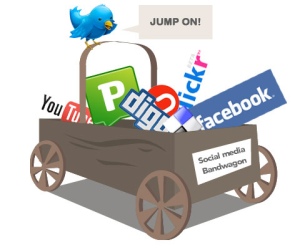Why do some of us shy away from trying out new technology such as social media? I can think of several reasons: too complicated to figure out; too expensive to implement; my supervisor/colleagues would never approve; more suitable for geeks and teenagers; it’ll take too much time … Or my personal favorite: I like things the way they are now.
 Yes, change can be a pain, because it can shake up your organized, structured existence. However, we can’t close our eyes and hope the Internet will go away. While I feel we should not jump onto the social media bandwagon just because everyone else is doing so, social media’s potential cannot be denied. Whatever the reason people give for avoiding social media, don’t let ignorance and fear hold you back from what will probably be the next revolution in the way people communicate.
Yes, change can be a pain, because it can shake up your organized, structured existence. However, we can’t close our eyes and hope the Internet will go away. While I feel we should not jump onto the social media bandwagon just because everyone else is doing so, social media’s potential cannot be denied. Whatever the reason people give for avoiding social media, don’t let ignorance and fear hold you back from what will probably be the next revolution in the way people communicate.
Social media is breaking down communication barriers: allowing people to reach out to others around the world – letting them connect, engage and share among themselves. Now more than ever, agricultural research and development organizations such as ours can leverage the popularity of social media to get more mileage out of their research outputs.
Social media tools can help you in your role as researcher, manager or communicator.
If all you’re interested in doing is organizing your online world, there are several social media tools that can simplify your life. These include social bookmarking sites that can help you organize your website resources and scientific literature. And if you’re struggling to keep abreast of updates from your favorite websites and blogs, newsfeeds may be your ticket out of mayhem. However, if you are yearning for more, hoping to connect with like-minded individuals or wanting to share your organization’s research with a larger audience so that it can be used, applied and improved upon, then read on!
The true value of social media lies in its ability to form communities organically. Often these communities, or social networks as they are called, come together because of common interests or a shared purpose. It is a nurturing environment filled with trust and camaraderie – the perfect milieu for effective collaboration and the sharing of ideas, information and knowledge. Add to that an outreach across vast geographical distances and the cross-linking between the different social media tools, and voila! You have a global, inter-linked audience at your fingertips.
Social media can give your communication strategy a boost in the following ways:
- It can help you tap into a large, global audience base and go where the people are these days – the Internet!
- The way people source for information has evolved. They are more discerning, preferring to seek out recommendations and suggestions from their colleagues, peers and experts. Information overload is a major concern, so people will not waste their time visiting a website, blog, database or any other resource unless someone they trust points them in that direction.
- The usual way we do business is slowly coming to an end. Pushing information out to your target audience does not guarantee that it will be read and used. Information is useful only when it is received by the right person, who is looking, at the right time. Use social media tools as vehicles to get your message out.
How social media can boost your communication strategy:
Increase Visibility
- Create awareness by raising the profile of your organization on social networking sites. Cultivate long term support for your organization by creating your own network of scientists, research partners and interested individuals.
- Use social media tools to promote your projects, events and activities. Announce time-sensitive, newsworthy items and get a head-start on others by microblogging. Microblogging involves posting short sentences (max 140 characters) that can be used to promote your journal article or a useful website, act as a reminder for an activity, or even ask questions. Tip: Ensure that your microblogging network consists of like-minded individuals who share your interests and concerns so that the information exchange is meaningful. Be prudent in selecting whom you follow.
- Promote your name: use social media to establish your reputation in the research and development arena. Blogging is a great way for researchers to share their research ideas with others and gain feedback from a wider, online audience. A recent Blog Tips post provides practical reasons why blog sites may surpass websites in generating traffic to increase Internet presence.Well-thought-out blogs attract people with similar thoughts and queries, people who can validate your ideas and also challenge you by sharing varying opinions.
Engage people
- Promote issues that resonate with people to encourage involvement and gather support for your cause. A great example of this is the Obama campaign which relied heavily on social media to garner visibility and support, resulting in victory for the Obama camp.
- Form strategic alliances with influential people and institutions that help boost your organization’s profile.
- Source expertise or talent, whether potential research partners, service providers or other experts.
- In the ICT-KM Program’s Social Media Tool series, I shared
 some thoughts on how social networking sites can help you engage with others. Reinforcing the sentiment that it is easy to find and connect with people of similar interests and even easier to set up online groups, Christian Kreutz and Giacomo Rambaldi provide interesting examples of local and global engagement. They also describe the various levels at which people engage while participating in social networks.
some thoughts on how social networking sites can help you engage with others. Reinforcing the sentiment that it is easy to find and connect with people of similar interests and even easier to set up online groups, Christian Kreutz and Giacomo Rambaldi provide interesting examples of local and global engagement. They also describe the various levels at which people engage while participating in social networks.
Share Knowledge
- Social media transcends geographic boundaries. Test your research ideas by sharing them with your colleagues globally. Collaborate, enrich and validate your work at a fraction of the time and cost associated with face-to-face meetings. As wide-reaching as it can be, collaborative sharing sites also come with security options that allow secure knowledge sharing.
- Create an environment where people recognize your expertise, and establish your organization as the expert in your field of research. Whether you are a researcher who is new to a field and eager to learn more, or the resident expert, share your knowledge and experiences by contributing to insightful blogs. I may be new to blogging, but already I’m learning so much from just opening up to a new community. My boss, Enrica Porcari, CGIAR Chief Information Officer, is a regular blogger and attests to its value. As she believes, and as I have been experiencing, blogs go beyond just sharing your words. The true value of blogging is in the exchange of information and knowledge, and the nurturing environment that allows differing ideas and opinions to emerge without defensiveness. See how these successful bloggers use their expertise to share and learn:
- Agricultural Biodiversity blogs (by Luigi Guarino and Jeremy Cherfas, who are living their passion for all things related to biodiversity in agriculture)
- ICT-KM Blogs (Blogs on knowledge sharing and social media in the CGIAR by 6 active bloggers and many guest bloggers)
- Blog Tips (On blogging and social media for non-profits)
- NEW: Rural Climate Exchange (new CGIAR blog connecting agricultural and environmental science to the climate change agenda)
- Share your photographs and videos online. Place useful slides online so others can learn from them. Tip: Think about the keywords/tags that you use to describe your product, such as blog, photograph, slides, videos, etc. How would you search for information online? Use that as a guide for your tags.
- Get more mileage out of your research outputs by filtering content to fit different social media tools. Think of social media as strategic communication lines that branch outward to several different networks, which in turn branch into other networks.
- Reach out to interested people outside your regular circle and gain valuable ideas/feedback from your pool of social networks. Practice what some call social listening.
As my colleague Simone Staiger-Rivas often quotes, “Social media is not about technology. It is about conversations enabled by technology.”
- Going beyond self-promotion, we should be paying attention to conversations that are already ongoing on social media sites; conversations that we are also passionate about. Sharing is a two-way process, and we should take the time to interact with others in a similar fashion.
- Share resources within interested communities and broaden horizons at a fraction of the time it would take to search for data or information or knowledge on your own. Social Bookmarks and Newsfeeds are great for keeping track of what’s being published on your favorite websites and blogs. Share this with others, and see the favor being returned manifold.
Consider your communication goals when you decide to incorporate social media into your strategy:
- Decide on whether you want to increase visibility for your organization, share knowledge or engage people.
- Choose the right social media tool(s) for your organization based on the target audience, research content and technology available.
- Start small. Many social media tools are relatively low-cost to implement in your organization:
- Experiment with a low-risk pilot project.
- Use short timeframes, anywhere from a few weeks to a few months.
- Evaluate your progress with pre-determined goals and measure its success. Read Antonella Pastore’s post on how to check if social media is working for you.
- In the event a social media tool does not work for your organization, it is wise to let go and start over with a different, more suitable tool. Don’t take it too personally.
Until you try social media out for yourself, you will never know what you’re missing. This reminds me of the days before the mobile telephone came along. Can’t imagine your life without it now, right? Similarly, the potential of social media is limitless. When you use several social media tools in tandem to inform, disseminate, share, collaborate and interact, you work within an environment of networks that grow exponentially. That’s power you can’t afford to ignore. Resistance is futile!
Till next time.
Resources:


 some
some 